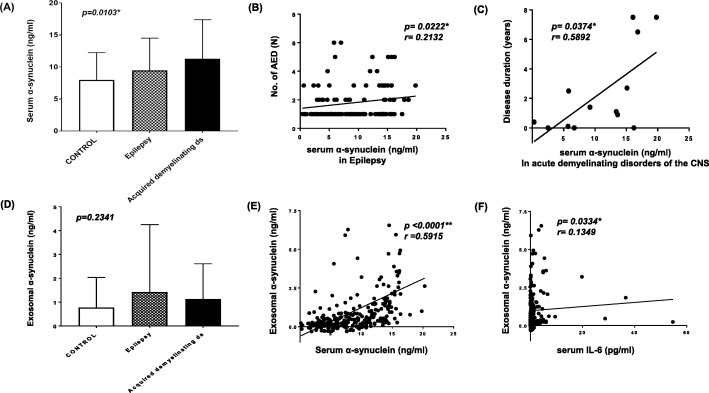Fig. 1.
Correlation of serum and exosome α-synuclein with measures of disease severity in epilepsy and acquired demyelinating disorders of CNS. (a-b) Mean α-synuclein levels from serum (a) and exosomal extracts (b) in patients with epilepsy (N = 115), acquired demyelinating disorders of the central nervous system (N = 18) and controls (N = 146). Acquired demyelinating disorders of the central nervous system include acute disseminated encephalomyelitis, neuromyelitis optica spectrum disorder, multiple sclerosis and transverse myelitis. (a) Mean serum α-synuclein levels showed significant differences in patients with epilepsy and acquired demyelinating disorders of the CNS compared to controls (p = 0.0103). (b) Serum α-synuclein levels showed a significant positive correlation with the number of antiepileptic drugs used by epilepsy patients (p = 0.0222, r = 0.2132). (c) Serum α-synuclein levels showed a significant positive correlation with the duration of disease in patients with acute demyelinating disorders of the CNS (p = 0.0374, r = 0.5892). (d) Mean exosomal α-synuclein levels were not significantly different in patients with epilepsy or acquired demyelinating disorders of the central nervous system compared to controls (p = 0.2341). (e-f) Correlation of exosome α-synuclein levels with serum α-synuclein levels (e) and with serum IL-6 levels (f) in combined groups of patients with epilepsy (N = 115) plus patients with acquired demyelinating disorders of the CNS (N = 18) and controls (N = 146). (e) Exosome α-synuclein levels showed a significant correlation with serum α-synuclein positively (p < 0.0001, r = 0.5915). (f) Exosomal α-synuclein levels showed significant correlation with serum IL-6 levels positively (p = 0.0334, r = 0.1349). Ds, disorders; No, numbers; AED, antiepileptic drugs; CNS, central nervous system; IL, interleukin

